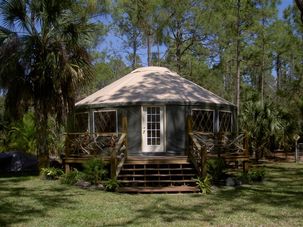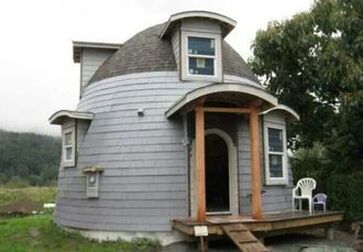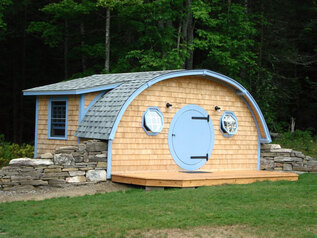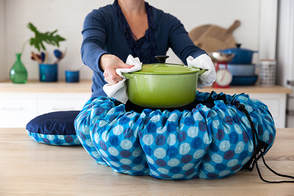 We have all heard about compost piles in which people discard food and other stuff. With composting toilets, you can put your waste to good use in your garden. I know what you all are thinking "Eww gross." Stay with me on this. Let me explain more about composting toilets. A composting toilet is an indoor toilet that processes human waste into usable soil. It requires no water usage whatsoever. If you're wondering about the odor, there is little to no odor in using a composting toilet. After one uses the toilet, human feces is mixed with either coconut coir, peat moss, or sawdust, in order to remove the odor and begin processing. Many individuals may use a waterless urinal in order to keep urine and feces separate (this isn't mandatory, this is up to you as a composting toilet user); excess urine in the composting chamber is unpleasant to some users of composting toilets. Again, it is up to you. Components of Composting Toilets Generally, composting toilets are made up of a place to sit, and the composting/collection part. There are 4 parts that make up the toilet: 1. Composting chamber/storage 2. Ventilation unit (This unit helps to vent the odorous gases and that all goes smoothly during the degradation process). 3. A Leachate collection system (this system removes extra liquid in the system). 4. Access door (This door is used to extract the compost from the unit). Uses for the compost Once the composting is complete, you will notice that the material is humus-like. Those who use composting toilets use the compost and soil for their gardens. Surprisingly, using this compost is beneficial to gardens, food or flowers. The material is said to have substantial nutrient availability. Getting into the legal stuff One would not think that there would be a law about composting toilets. However, several states have rules about how to dispose of the material from the toilet. Some of these states include:
Closing thoughts While the upkeep of a composting toilet may be tedious at times, it seems worth it if we are cutting down on water usage and enriching our gardens with materials from the compost. Not only that, but we are also helping to keep rivers and streams clean from water waste. If that doesn't seal the deal on using a composting toilet, I don't know what will, LOL! One more thing, when the collector on the toilet becomes full of material, it is time to empty it. You don't want to let it sit for too long, as your space can become odorous.
0 Comments
 Many individuals in this country use city water or well water as their water source. For those who are looking to go greener, and save green, you can choose to harvest rainwater as your water source. Those who choose to harvest rainwater to use for ingesting and cleaning have their reasons. The majority harvest rainwater for environmental reasons. When one uses a stream or lake as a water source, you are tapping into the home of many species of wildlife. It would be like uninvited guests breaking into your home and stealing everything that makes it a home. It's like that for wildlife. Those who harvest rainwater know this and want to preserve the habitat for the species of animals that live in that area. You may be thinking: "Not much rain falls from the sky. How can I use rainwater as a water source for my family of six?" Let's talk numbers, shall we? According to the USGS, one inch of rain falling over one acre of land is equivalent to over 27,000 gallons of water (The average household goes through nearly 100,000 gallons of water annually). If you want to talk about the weight of one inch of rain over one acre of land, we are talking about 113 tons of usable water! "Okay, well I live in a part of the country where it snows a lot. Am I able to harvest snow?" Yes! One inch of snow falling on one acre of land is the equivalent of 2,715 gallons of water. If wet snow is falling outside your window, you are looking at 5,400 gallons of usable water for every inch that falls from the sky. How can I catch rainwater and harvest it for use? Well, the most popular way families harvest rainwater is through a system of gutters and downspouts. The downspouts and gutters collect the water, and the rainwater travels down to a compartment called a cistern. The cistern acts as a way to house and decontaminate the rainwater so it is safe for human consumption. In areas of the country that are prone to harsh winters, it is recommended that cisterns be installed underground.
While you can install a rainwater harvesting system yourself, it is recommended that you work with a specialist in order to avoid mishaps during construction of the system. Also, you will want to have an expert make sure that the water is safe to consume. Is the harvesting system complex? Yes. However, when you think about all the pros to harvesting rainwater (mentioned above), the pros outweigh the cons. In my opinion, I think every house should harvest rainwater. #rain #rainwater #harvesting #minimalist #tinyhomeliving #offgrid #water #watersource #lifestyleblogger #lifestyleblog #travel #happiness #success #nature #goals  Tiny home living is a movement that I have been fascinated with for a while now. It's been only recently where I have decided that I want to live in a tiny home, when I'm able to. Up until last week, I thought that the only tiny homes that existed were on wheels. WRONG! I watched a documentary, and it showed a woman looking for a tiny home. She came across a "Yurt." It was this large, circular building with a white covering. I had never seen anything like it in my life, but I was amazed by how much space there was. In this specific yurt, there was a kitchen to the back, a sofa in the middle of the room, a fire place, and along the walls were little pod rooms. The pod rooms consisted of bedrooms, storage rooms, and bathrooms. The yurt did not have any electricity or running water. The lady wasn't crazy about the small pod rooms, but she bought the yurt anyway. She made some adjustments, however. She created a loft bedroom that was accessible by steps. I did some researching and found that you can build the yurt yourself (you would just pay for the building kit, which would run you about $8,000). Obviously, you would need the land to build it on, and you would need to obey zoning laws. Once a yurt is set up on your land, you can construct the inside however you want. If you want running water, you can have a well put in on your land (or, you can harvest rainwater. This would be the less expensive and more environmentally-friendly way to get water). Many yurt homeowners have power and have internet. A lot of yurt owners use solar panels, which can be installed next to the yurt. Sure, a yurt may seem like you're on a never-ending glamping trip, and many people do use yurts to go glamping (there's nothing wrong with that, by the way). However, there are people who use yurts as their residence. People can live comfortably in yurts, in any weather situation, in any part of the world. You don't have to be a "hippie" in order to live simply.  The tiny home movement has gained momentum in the last several years, with the highest interest in tiny homes occurring shortly after the recession of 2008. With more individuals joining the tiny home movement than ever before, many people, including myself, have been sharing what we know with the rest of the world. People live in tiny homes for a number of reasons, many of which include finances and wanting to be greener. One of the most intriguing and economical tiny homes is a Dome home. A Dome tiny home is one of the best homes to choose from if you are looking for a home that is more enclosed. The majority of these Dome homes are all one floor. When it comes to size, kits and plans can be as small as 160sq feet and as large as 1,100sq feet. The thing that sets Dome homes apart from its competition is the fact that they are easy to construct. Also, they are one of the most inexpensive tiny homes around!  The tiny home movement has been sweeping the country for the past several years. People yearn for the simplicity of living in a tiny home, and with the way the economy is, it is no wonder the movement has grown so immensely. When it comes to tiny homes, you have the mobile tiny homes, where you can take your home anywhere you want to go. You have Yurts, which are incredible tiny homes to put down your roots in. One type of tiny home that is growing in popularity is a Bodega home. The Bodega is a very nice tiny home. The thing that makes the Bodega different than other tiny homes is that it isn't mobile. So if you plan on living in a Bodega home, make sure you have land to build it on. Your Bodega may cost you anywhere from $15,000 to $25,000 to build. On some Bodega homes, you are able to expand the space for an extra bedroom or home office. Bodega homes can be as small as 65sq feet, and as large as 800sq feet. So, if you're planning on settling somewhere, I would highly suggest that you consider investing in a Bodega house. This type of tiny home is one I am seriously considering (once I'm debt free of course, LOL). I'm torn between a Yurt and a Bodega, LOL!  If you're like me and you work from home, you probably long for a space that can be a genuine office space. Since it costs a lot of money to rent space in buildings, one company has come up with an ingenious idea to construct archipods. An archipod is a curved structure that can be placed in your backyard. Inside these archipods, you have porthole windows, an ergonomic semicircular desk, and a top-hinged gull-wing door that is weatherproof. There is also plenty of storage space for wireless routers, modems, paperwork, phones, computer units, printer ink/paper, and much more (maybe even a tiny fridge to store all those V8 V-Fusions that you chug down in order to keep up the momentum to get things done. Oh wait, that's me, Ha! I digress.). The archipod comes in two sizes: "the archipod," which is at a diameter of 9'6" internally, and 8'3" to the top of the structure. The next archipod is called "the bigger pod." This pod is ideal if you have more than one associate working for you, or you have a lot of clients coming over for meetings. This building is 12'6" inside, and 8'5" to the top of the structure. The bigger pod comes with a longer semicircular desk, enough to comfortably seat 2 of your associates. Both buildings are equipped with power outlets, phone outlets, and more. There is only one company that I know of that makes quality archipods, and that is Archipod. You can visit their site here for more information and pricing. Also, not all buildings are designed the same. I've found photos of archipods that have the semicircular desk on one side, and a couch on the other. This works perfectly if you do have clients visiting you. Your clients will have a comfortable place to sit as they seriously consider working with you (by the way, who wouldn't want to work with someone who works inside an archipod?). If you homeschool your children, this could be a great learning space for them! #tinyhouse #tinyhome #tinyliving #workfromhome #officespace #diy #HomeInspo #Decor #Home #InstaHome #Archipod #remote #remotelearning
 I know what you are thinking: "There is no way a human can live in a hobbit hole." You might be surprised. In fact, there is a man in Oregon that has lived in a Hobbit Hole for the last 20+ years. He became interested in living a simpler life when he read "Payne Hollow," by Harlan Hubbard. Along with the Hobbit Hole, Dan Price constructed a bathhouse, workshop, garage, and sauna. He lives comfortably off of $5,000 a year. There are many types of Hobbit Holes that one can live in. The standard for most people seems to be the Hobbit Hole cottages. These cottages have a 4'6" round front door, a 14' x 12' inside space that consists of a dining area, kitchen area, living room/bedroom, and a porch. If you are not ready to live a simpler life in a hobbit hole, these hobbit holes do make great playhouses for the kiddos. Take a look at the inside of a Hobbit Hole:  Ready to "live in zen?" Being a part of the tiny home movement is all about becoming more down-to-earth. It's all about minimalist living and focusing on what is important in life. If you are looking to slow down in life and become more centered, architects Matthias Pruger, Ulrike Wetzel, and Manuel Rauwolf, designed a tiny house that they call "Seelenkiste (it means Spirit Shelter or Soul Box)." They designed this Spirit Shelter as a meditative space. The space is designed to be used for reading, studying, and meditating. You can use it to become more mindful, more in the 'now'. Becoming mindful is something we all should be doing. This world is chaotic. We have an abundance of stress on our shoulders and we are worrying about things that are out of our control. This tiny space can help you control your stress and your emotions by sitting quietly and focusing on your breath and the sounds of nature. Some individuals live in the Spirit Shelters, while others have one in their backyard. Now, would I ever live in one of these? No. However, I would like to have one of these on my property as a meditative sanctuary. Those that know me offline know that I am all about mindfulness meditation. Mindfulness and meditation entered my life at the lowest point in my life, and has significantly helped me heal new and old wounds. I need my sanctuary to be somewhat separate from my living space, that way I don't bring any unwelcomed energy into my living space.  Welcome to the revolutionary Wonderbag! Many people who are considering living 'off the grid' are wondering how they can make meals for their families. Many of today's modern tiny homes have a full kitchen with a stove, oven and refrigerator. For those who are looking to abstain from modern amenities, may I introduce you to The Wonderbag? The Wonderbag is a slow cooker that you do not need to plug in, nor does it require fuel. Obviously, you need a portable burner, or a fire pit to bring your food to a boil (in a cast iron pot). After your food starts to boil, you can insert your pot into The Wonderbag, where it will continue cooking for 8 hours. The inventor of The Wonderbag, Sarah Collins, developed the bag to help those in developing nations cook food without burning fuel (which is very hard to come by in those parts). Sarah Collins has been bringing this invention to mainstream attention and will actually deliver one Wonderbag to a family in Africa for every Wonderbag purchased here in the United States. So, if you're looking to be completely free from modern amenities, I definitely suggest purchasing this Wonderbag. Not only will you be doing something great for the environment, you will be helping our friends in Africa feed their families. The bags are decently priced at only $50 (that's much cheaper than the modern slow cookers lining the store shelves). If you're interested in purchasing one, or you are interested in learning more about The Wonderbag, click here.  One would think that harvesting rainwater wouldn't be an illegal action. After all, it falls from the sky, and it doesn't get used. It's a free for all. We should be using it! Officials have a "very good" reason for banning rainwater use: "It belongs to someone else." Officials believe that people steal rainwater from streams and rivers and harvest it that way (for the most part, that is NOT TRUE). Several western states (Colorado, Utah, Washington, Oregon, to name a few) have outlawed harvesting rainwater as a water source. In fact, if you are caught harvesting rainwater, as one gentleman found out, you are fined and sentenced to jail. Gary Harrington, a rainwater harvester from Oregon, was convicted of harvesting rainwater and was sentenced to 30 days in jail. He willingly served his time as a protest of the ban on rainwater harvesting. A study was done in 2014, and it showed that harvesting rainwater would greatly reduce water bills. It was also shown that harvesting rainwater is the best thing to do for the environment. My Two Cents How does rainwater belong to someone else? Rain belongs to no one. It is a water source that is severely underused and one that can greatly reduce water shortages across the world. Can you imagine the amount of money people will save by just harvesting rainwater? It's not even about money; we would be doing incredible things for the environment. Rainwater is there for us to use. I don't understand why officials are blocking this substantial water source. If you are looking into using rainwater as a water source, make sure your state allows you to do so. |
ArchivesCategories |
©2017-2024





 RSS Feed
RSS Feed